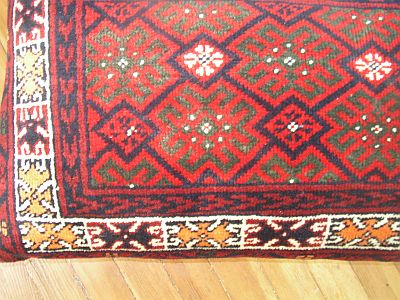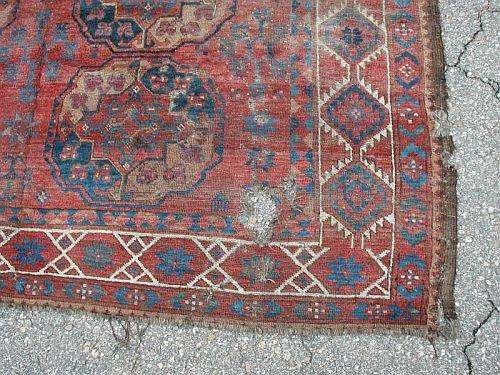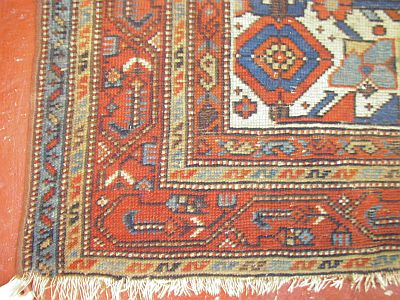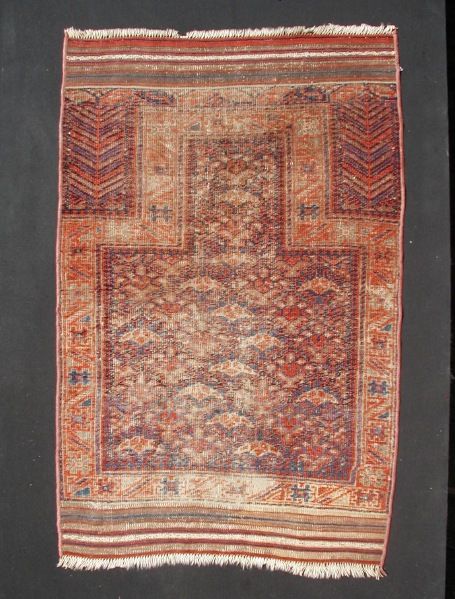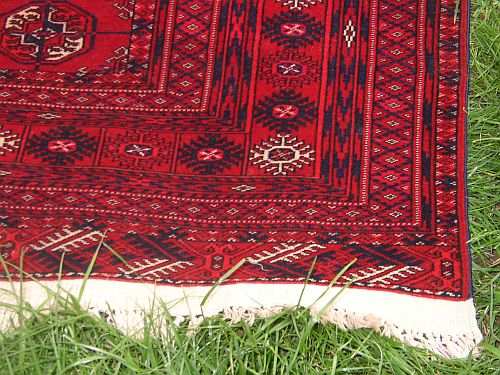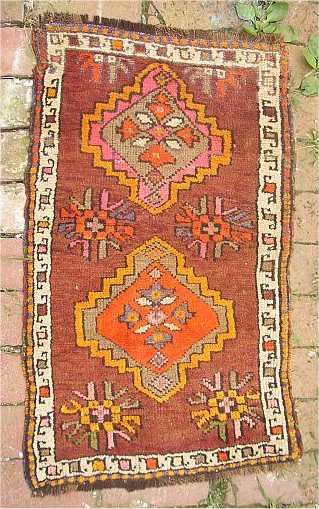Posted by David R. E. Hunt on 09-06-2003 07:17 PM:
Intentional Mistakes?
All- Granted, while it may at times seem that these "intentional mistakes"
are proffered as excuse for weave defects, I for one am not so sure that this
concept is merely an imaginative sales pitch for faulty merchandise. This faulty
corner resolution, advanced by the authors as substantive evidence, does seem a
wide spread and common weave phenomonon- it seems to me readily apparent that
these corners could easily resolved if the weaver actually wanted to. Also, I
must admit that in many of the weave defects that I have encountered, it seems
hard to believe that the weaver could not have noticed, or for that matter have
not corrected many of these mistakes-those faulty constructions of interior
details of design elements in which the surrounding , often intricate design
remains unscathed immediately come to mind- any published research on the
subject? So ofen, in folktales, rumor, and even predjudice, there lies a kernel
of truth- so what of this?- Dave
Posted by Steve Price on 09-06-2003 09:39 PM:
Hi David
My brain spins a bit every time I see the phrase "intentional
mistake" used to describe some unanticipated (by the western viewer) alteration
in design or color. The essence of something being a mistake is that it is not
intentional. So, I prefer to call them irregularities.
Let's take a look
at one of the examples Muhammad and Nasima presented.
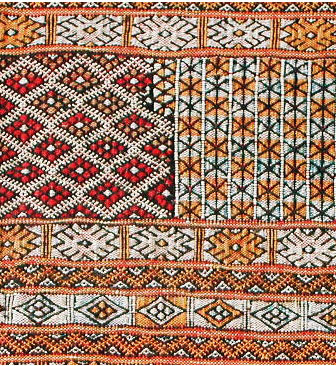
Here's a very obvious
irregularity. We can ask some questions about it. First, is it an error (that
is, was it done unwittingly by the weaver)? Clearly, it is intentional. That was
easy.
The next question isn't, though. Since it was done intentionally,
why did the weaver do it? One hypothesis, put forth by Muhammad and Nasima (and
by many others before them), is that it is essentially a religious act, an
acknowledgement of the necessity that anything man-made must be imperfect. I'd
think this is a testable hypothesis, the simplest test being to interview some
of the weavers and ask them. It's possible that they wouldn't always answer
truthfully, but it would be a pretty good way to start. They might say exactly
what Muhammad and Nasima say. They might say something else that makes sense.
Either way, that approach seems a much better path to the truth than either
insisting that the hypothesis must be correct or insisting that it must be
incorrect.
Regards,
Steve Price
Posted by Filiberto Boncompagni on 09-07-2003 04:04 AM:
Dear All,
I have little doubt that the above example is a deliberate
anomaly.
I agree that a widespread explanation for these anomalies is of the
sort "perfection belongs only to Allah".
My humble opinion is that it looks
like a device against the ancient universal superstition of the evil eye -
renamed with a new "Islamic politically correct" label.
Syncretism DOES
exist in Islam.
A further corroboration to my opinion is that such
deliberate anomalies are found all over the tribal/rustic Oriental rug world -
but are also CONFINED there. Tribal/rural societies are more likely to preserve
old superstitious habits than the urban ones.
Yes, I wrote "tribal",
although our hosts seem not to agree with the term - or at least they seem to
attribute to "oriental rug collectors and writers" a somehow inferior
valuation:
There is a tendency among oriental rug collectors and
writers to view these textiles as tribal and primitive as opposed to
decorative/aesthetic and meditative; to look to the Amazigh (Berbers) as a
pastoral people rather than as amongst the builders of the high art of
Marrakech, the Alhambra and Muslim Spain. This western view is condescending at
best.
Well, considering that most of Westerner oriental rug
collectors value tribal rugs MUCH more than the decorative ones, I think the
misconception, dear Muhammad and Nasima, is yours!
Let my continue with
anomalies: you see them as an act of devotion by the pious Muslim
weaver/artist.
If this is the case, why don’t we found deliberate anomalies
in workshop or Court carpets?
(At least, if they are any, I’m not aware of
them. I’m open to contrary evidence.)
And why don’t we found examples of d.e.
in other forms of Islamic art - say, metalwork or architecture?
Are there any
examples of deliberate anomalies in the Alhambra, Ibn Tulun Mosque or Taj
Mahal?
As I said, I’m open to evidence.
Best
regards,
Filiberto
P.S. Steve is right: the simplest test being to
interview some of the weavers and ask them. 
Posted by Steve Price on 09-07-2003 07:54 AM:
Hi Filiberto
I believe Muhammad and Nasima are correct in saying
There is a tendency among oriental rug collectors and writers to view
these textiles as tribal and primitive as opposed to decorative/aesthetic and
meditative; to look to the Amazigh (Berbers) as a pastoral people rather than as
amongst the builders of the high art of Marrakech, the Alhambra and Muslim
Spain. This western view is condescending at best.
The fact that we
(you and me and most of Turkotek's readership) value tribal and village art more
than workshop art doesn't contradict that at all. In fact, one of the great
attractions of tribal art to many collectors is the opportunity to vicariously
participate in exotic, primitive cultures, with interesting superstitions (I
should add, superstitions that are interesting because they are so different
than the ones that abound in our culture).
The same phenomenon can be
seen among collectors of African tribal arts, the value of which has an
extraordinary dependence on the likelihood that a piece was used in tribal
ritual.
Regards,
Steve Price
Posted by Filiberto Boncompagni on 09-07-2003 09:20 AM:
Hi Steve,
Perhaps. Or perhaps not.
My understanding of those
sentences is that trying to distinguish between ‘tribal Berber people and/or
their art’ AND the ‘urbanized Berber people and/or their art’ is condescending
at the best.
Is my interpretation correct ?
The answer to our hosts,
please.
Regards,
Filiberto
Posted by Filiberto Boncompagni on 09-07-2003 09:44 AM:
Or better:
there is only ONE Amazigh (Berber) entity, the builders of
Alhambra etc. SO we cannot separate the art they produced under pastoral
condition from the high art of Marrakesh
etc.
Regards,
Filiberto
Posted by Patrick Weiler on 09-07-2003 01:31 PM:
Intentional Imperfections Misguided
I do not know the origin of the "intentional imperfection" tradition. Is it
actually noted in any specific religious text?
The concept appears to be
nonsense when considered logically.
If only God can make things perfect,
and if
God made everything, then everything is perfect.
If God made you,
then you are perfect and everything that comes from you, having come from God,
is therefore perfect.
Taking this another step further, even the
"intentional imperfections" are thereby perfect.
Darn.
Perfectly
Patrick Weiler
Posted by Muhammad Thompson on 09-07-2003 03:12 PM:
Filiberto, please do not overestimate our knowledge - we are not experts. We
would like to know more about the "evil eye" as a possible cause of anomalies;
we are ignorant of this. (I must say we are sceptical of this approach to the
textiles just as we would be impatient with someone who tried to describe a
Constable landscape by reference to the English superstitions of walking under
ladders, black cats or broken mirrors.)
I am sorry Filiberto, we haven't
studied the buildings and the art forms you suggest to know if anomalies are
found in the same way as these textiles. It is a good question but I think
wherever the artist is in a position of working for someone else, anomalies are
likely to be much less apparent if they exist at all.
What we did do in
the article was describe two types of anomalies in kilims - one is obvious, the
other more concealed - and we suggested that whenever the artisan is employed or
commissioned it is more likely that the anomaly will be inobtrusive; they will
be more careful to avoid the financial loss resulting from someone considering
the work defective. Where they work alone and especially when they weave for
their own homes, the anomalies can become much more a part of their style.
Yes, the views of the weavers should be critical in our efforts to
explain, understand and appreciate. Marla Mallett's website is one of the few we
have come across that mentions conversations with weavers in this
respect:
"Rigid, mechanical-looking "factory" rugs and other weavings
have short-lived appeal; in contrast, one can quickly grow fond of the
irregularities that occur routinely in village and nomad textile art. Abrupt
changes in color, motif or proportion reflect a carefree, lively attitude toward
the work. Such anomalies are not considered mistakes, nor are they signs of
inept work. Unmatched pattern repeats rarely bother the weaver; many indeed are
purposeful. I have heard women laughingly dismiss peculiar design irregularities
in their work as "more interesting." I have seen mothers reluctant to correct
their daughters' work. Weavers are unconcerned by erratic shifts in warp fringe
color, unconcerned when their weavings are irregularly shaped. We too must
realize that the essential qualities in this folk art are freshness, vitality,
pleasing color, superb materials and excellent design."
Given that this
notion has done the rounds (over some years?), shouldn't the paucity of other
hard data on this topic, tell us something? Perhaps contributors will come to
our rescue in the days ahead.
Posted by Ali R.Tuna on 09-08-2003 05:29 PM:
In all this discussion with Intentional mistakes and if is it linked to
religion , we can also turn our look to the court carpets and textiles from the
Islamic countries. Who , better than the Sultan , his court members and the
"Ulemas" (religious leaders) would be better representing the official doctrines
and interpretations of the religion.
Yet , in all carpets and textiles made
for the court and the elite class, we find a sense of perfection which was
considered as the quintessence of the carpet art. At least we know that at their
times , this is what was seen as the "best". This has also continued till
present times (see the Persian carpets made for the rulers , even today"s silk
Herekes made for the Gulf countries etc..).
Even the abrash - so sought
after today- and probably is also an effect of the time rather than the original
manufacture, was considered as an imperfection and a mistake.
If we look
at the other art forms in Islam , i.e. the miniature , tilework , bookbinding,
it is difficult to sustain that what was considered as an imperfection or
mistake was deliberately introduced to confirm modesty versus God's creations (
Patrick Weilers logic seems flawless to me) .
So the "easy explanation"
of the imperfection introduced looks more like carpet dealer's arguments than
anything else (there are obviously more affordable carpets than the court
carpets- I do not consider the less perfects artistically inferiour
though).
This said , we should not rule out that the introduction of
assymetries , irregularities and other interruptions of the order were
introduced as a deliberate artistic effect. Especially , not knowing the real
context in which these works were executed (time gone by and weavers not willing
to share) we might be "mistaken" to interpret them in the current
context.
I am posting two paintings below , that , interpreted within the
Renaissance context would be full of mistakes but also full of charm (Two
Picassos).
They are obviously full of "mistakes" anatomically , but is there
a parallel we can get from there for our textile mistakes?
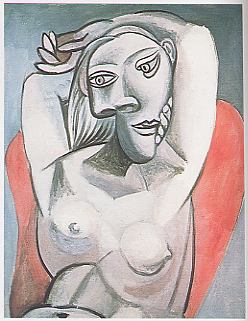
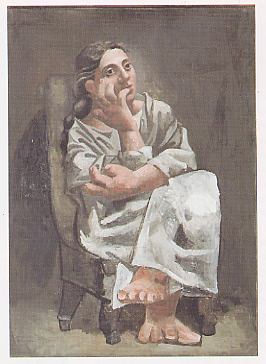
There are huge differences
between today's Islam as some people interpret and tend to define it and the
free thinking that the original religion has created with all the scientific and
artistic curiosity , experimentation and also fraternity it has created . Within
that context the encouragement for sciences , exactness , logic thinking and
order (that were all reflections of God's properties) I can not imagine the
lesser quality creation could be imputed to the religion.
As such , I
tend more to embrace the "atomist " explanation where the introduction of the
singularity through regularity has a philosophical importance (not that people
philosophed when weaving but this thinking has generated a mind set and a style
of designs) in the Islamic view of the construction of the Universe (Just think
about the Big bang) .
By ordering the basic elements the same way in some
order is an act of prayer like "tesbih" (like a chaplet) meaning repetition of
the name and reality of God in this world , than changing it once and starting
again in a slightly modified order goes to the base of the islamic philosophy.
This is different than the rhytmic orders obtained by normal tribal
art.
This goes beyond in its search for new combinations in the infinite
and in its beauty. This is how several of the nice ornamental patterns were
created.
This is why I believe that some singularities can be necessary in
islamic art , like the silences in a music sheet before a new pettern/order
starts.
Ali R.Tuna
Posted by Muhammad Thompson on 09-08-2003 05:30 PM:
Patrick's question
Sorry Patrick, I can't share your logic but I would like to try to respond to
the question you began with:
We don't know of any religious ruling about
this topic for the specific activities of weaving, the arts or crafts; the idea
was related to us by a Meknes rug dealer. (There are very clear prohibitions on
the making of "pictures" - we will refer to these in another strand.)
The
situation however, is a familiar one for muslims, we think.... and easily
understood by anyone who has made something?
Any small successes we have
in creating or making something often results in us pausing or even dwelling
upon and marvelling at what we have done. A certain amount of pride is evoked by
our handiwork and we may even become a little blind as to its shortcomings. If
the object we have made is always around to catch our eye and imagination, or
the activity a frequent one for us, a great deal of time can be wasted and pride
engendered by the objects created. For someone who considers pride to be a sin
and the time spent being proud to be time wasted, some techniques need to be
devised to divert these tendencies.
The anomalies in some Moroccan
kilims, may provide such a technique; a free and easy attitude to the weaving
(described on Marla Mallett's website and quoted above), may be another method
of avoiding this pitfall of the creative process: a muslim should not become
attached to the earthly things. Pursuing perfection in an art or craft can
therefore have its dangers.
We will try to expand on our understanding of
the Islamic attitude towards human, creative behaviour, in the strand,
(Baker....) which John has started; in brief, the pious muslim attempts to gain
knowledge of the attributes of Allah and to share (in a small, human way) those
attributes. The muslim need be ever mindful of the difference between the human
and the divine. Man is evidently not perfect but struggles for the salvation of
his soul.
Posted by Steve Price on 09-08-2003 06:36 PM:
Hi Muhammad
I noticed in your Salon essay, and was reminded in your
last posting, that you and Nasima tend to refer to Muslim practice as though
there was only one variety; one set of ways of doing things. I have a number of
Muslim friends, students and colleagues, and have visited Turkey 5 times. My
observation is that there are probably as many variations in the the practice of
Islam as there are of Christianity. The core beliefs may be the same for all
Muslims, but the specific practices aren't.
Turkey's population is
virtually entirely Muslim - the government is strictly secular (even more so, in
some respects, than that of the USA). In Tokat, seeing a woman with her hair
exposed is unusual. In Istanbul, most women dress as westerners. They are all
Muslims in a Muslim society.
Your last post mentions a strict
prohibition on the depiction of the human, but there are lots of rugs from the
Muslim world with humans drawn pretty realistically, some showing specific
individuals. Last night I was browsing old Christie's catalogs and ran across a
15th or 16th century Turkish manuscript page that included a color picture of
The Prophet Mohammed. I'm not sure what all this proves, but it is inconsistent
with a strict prohibition on Muslims depicting humans. So, I suspect the strict
prohibition applies to some branches of Muslim practice, but not to all.
It will complicate our thinking somewhat, but it's probably useful to
either specify the range of variation within rug-related practices or focus on
those practices that really are nearly universal among the
Muslims.
Regards,
Steve Price
Posted by Muhammad Thompson on 09-08-2003 07:47 PM:
Dear Steve
Yes I am sorry if we gave the impression that Islam was
monolithic; your observations on its diversity are correct. No two people will
practice the religion in quite the same way. No two people will understand it in
the same way or find it easy to follow in exactly the same way.
(We feel
poorly equipped to answer many of the questions which are now emerging about
Islam but we welcome their emergence.)
You said that our "last post
mentions a strict prohibition on the depiction of the human"; I think we
actually said "a clear prohibition on pictures", and it is usually interpreted
to mean "pictures of living creatures".
As we say in another strand
(Baker .....), this is not upheld at all times and in all places despite the
apparent clarity of the hadith. Representations of people, even of The Prophet
(usually veiled), are not hard to find. Today, pictures in the broadest sense of
that term (ie including photographs), are found throughout the muslim world.
Differences in scholarship, in interpretation of the The Qur'an and the
hadith, are probably the primary reason for this diversity.
Yes, let's
confine the discussion to the local interpretation of Islam as it unfolded in
north Africa and it's effect upon the textiles produced by the Amazigh?
Posted by Steve Price on 09-08-2003 08:12 PM:
quote:
Originally posted by Muhammad Thompson
... let's confine the
discussion to the local interpretation of Islam as it unfolded in north Africa
and it's effect upon the textiles produced by the Amazigh?
Hi Muhammad,
I think this will help to keep us from
getting into a lot of confused and confusing circles. Thanks.
Steve Price
Posted by R. John Howe on 09-09-2003 07:19 AM:
Dear folks -
Just to connect Steve's indication above with some other
information we have in this salon in another thread, there is a section in one
of the links on Islamic art that Filiberto has provided (I cannot find it again
at the moment) which says approximately that Moroccan artists do not indulge
much in figural representation but that the Persians have always exhibited a
taste for it.
Just a related point that I cannot ducment either at the
moment because its source is "lost" somewhere in my library here. I have read a
treatment of this issue by a long-time British student who expressed great
disdain for most explanations of such differences. He especially rejected the
wide-spread view that the Persians use more figural representation in their art
than did other Islamic cultures because of they were of the Shia
faction.
He pointed out that all of the factions of Islam have their
authorities and all of these discouraged the use of figural images in art, the
Shia included. His explanation of the fact of figural usage by Muslim artists in
Muslim societies was that, as with all other faiths, there are Muslims who hold
their beliefs more closely and some who hold theirs more loosely and who do not
always adhere with precision to all the prohibitions.
He also presented
quotations from history, including some claiming to be from Mohammed's own
household in which the thrust of the prohibition seemed to be two-fold. First,
artists were not to take on to themselves any of God's creative function in
their art and second to make sure that idolatry did not occur as the result of
the use of figural images. So, this authority said, one might not use figural
images on a textile that was to be used in a mosque, or one that was to be
placed at home on a wall, or one that was to be worn. But it MIGHT be
permissible to use figural images on something that was being walked on, such as
a carpet.
But it appears that the Muslims in Morocco mostly observed the
prohibition against figural images in their art. At least I have not found a
textile with human or animal figures in any of my Moroccan rug
books.
Regards,
R. John Howe
Posted by Filiberto Boncompagni on 09-09-2003 09:56 AM:
Hi John,
Your "British student" is probably right. Perhaps Persians
where more indulgent on figural representation for their historical and cultural
identity - let us say for a sort of nationalistic pride.
I’m told by an
Iranian acquaintance of mine that "portraits of Prophet Mohammad and Ali
Miniatures can be seen everywhere in Iran. Go to Isfahan and you will see tons
of pictures of depicted human figures on the walls…In Chel Sutun in Isfahan,
different battles are depicted during Safavid time".
This should be one of
them:
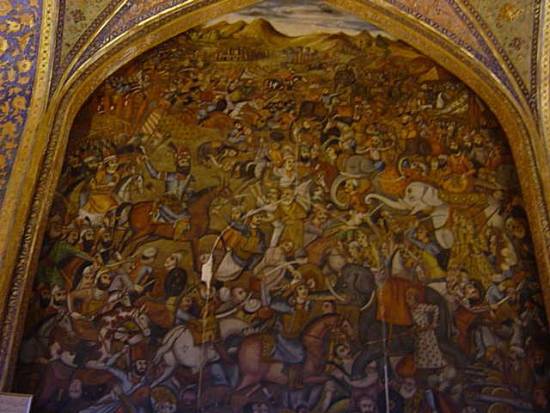
I found out that we can find frescoes with human depictions
also in Islamic buildings outside Persia: in the Umayyad and 'Abbasid palaces
and in Spain, and in the harem quarters of the Mughal palaces in India.
There
is an example here in Jordan: Umayyad castle, Qasr Amra, 8th
century.
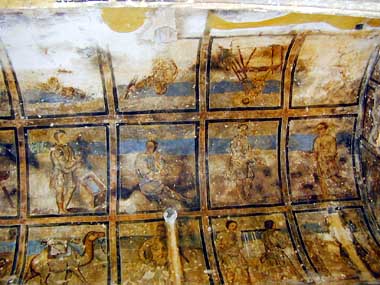
Those
were secular buildings, though. The prohibition Was enforced for sure on
religious buildings all over Islam.
Regards, Filiberto
Posted by Filiberto Boncompagni on 09-09-2003 11:14 AM:
Dear All,
I think you should enjoy this mosaic pavement from another
Umayyad building: Khirbat al-Mafjar, a complex consisting of a mosque, a castle
and elaborate baths near Jericho, c. 740 AD.
The mosaics in the baths consist
primarily of geometric patterns with the notable exception of this one.
The
subject has been interpreted as an allegory: the gazelles peacefully nibbling
the leaves of the tree on the left symbolize the blissful state under the
Umayyad rule. The right side represents the wrath of the Umayyad caliph against
his enemies.
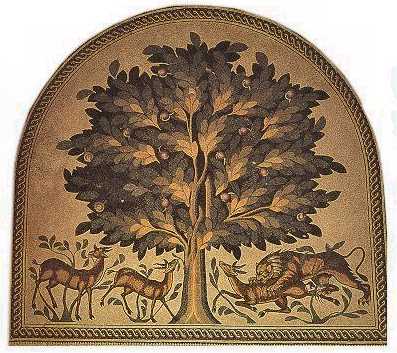
Filiberto
Posted by Filiberto Boncompagni on 09-09-2003 11:20 AM:
Uh, sorry, re-reading the thread I realize I am definitely digressing… 
Regards,
Filiberto
Posted by Michael Bischof on 09-09-2003 02:11 PM:
...cannot imagine !
Hallo everybody, dear Muhammad Thompson,
I can talk only about my own
experience. Never ever I heard such a thing from weavers or villagers in Iran,
Syria or Turkey - just several times from carpet dealers in the big centres. It
sounded for me a bit wrong: these people are fond of oral communications and do
not sport to read books. The way they explained it sounded "written", reciting
something one has read somewhere...
I must admit they I never had
long-lasting close contacts to member of the Intelligentsia in these countries
so how they feel and express that I do not know.
quote:
The muslim need be ever mindful of the difference between the human and the
divine. Man is evidently not perfect but struggles for the salvation of his
soul.
Believe me: if you are a weaver or a villager who deals
with wool or dye stuff plants you do not feel about to forget the difference
between the human and the divine - by creating a carpet! Your experiences,
troubles and worries about the piece are so much "from this world" that there is
no temptation in this direction . When the middle men of the cottage industry
enterpriser come and cut some of the agreed upon money claiming slight detail
mistakes you would feel tempted to the opposite side: it would have been better
to compete harder with God in the direction of perfection and total
harmony...
According to what I know carpets have never been made by rich
city dwellers who occasionally sat in their garden and, like with a hobby, from
time to time felt the need for some artistical self-expression so they sometimes
moved such philosophical thoughts in their brains ...
In short: I cannot
imagine that this idea ever played any role in such a Near or Middle Eastern
country side environment where carpets were made. May be, just a phantasy, the
well-educated director of an important court workshop had such ideas. But not
his weavers ...
Regards,
Michael Bischof
Posted by Muhammad Thompson on 09-10-2003 04:12 AM:
Re. the wisdom and good taste of kings, governments and the
intelligentsia
Dear all,
I am sure I am not alone in thinking that there are all
kinds and grades of scholarship and governance. Certainly in Islamic history
there are what are often described as "the rightly guided caliphs" (Abu Bakr,
Umar and Uthman and Ali, may Allah be pleased with them) and those that came
after.
And in the field of scholarship, there is a long tradition in
Islam of scholars needing to avoid and distance themselves from all kinds of
patronage in order to maintain their duty to Allah and intellectual honesty.
We will not be surprised to find that leaders, muslim and non-muslim,
often procure scholarly support for ends which they find convenient but which
have poor or non-existent intellectual justification.
So I don't find
arguments based upon some "courtly standard" of good taste or scholarship to be
automatically convincing. Sometimes the purest manifestations of belief are
found amongst the lowliest not the highest members of society. I have tried to
describe on a new thread (Berber history...) why this might be an important and
motivating factor for Berbers who led the equivalent of a protestant reformation
in their country on various occasions.
I don't know why the Persians did
produce pictures; it is possible their scholars did not know of the hadith in
question or chose to follow other false hadith. I think there are known
instances where hadith were fabricated in order to justify the desires of the
powerful. (There is an account at page 524 of "Islam: Art and Architecture", eds
Hattstein & Delius, which describes the emergence of figurative painting in
the Safavid period; this book attempts to chronicle some of the disputes
regarding the topic throughout muslim history.)
... and because I am a
fan of the writings of the great, twelth century scholar, Imam Al Ghazali, allow
me to recommend a reading of his introduction to his Book of Knowledge; we do
not know exactly who it is addressed to but it is a wonderful, flowing and
stinging attack on scholars who have obscured the religion to please the rich
and mighty. (You can read an excellent translation by N Faris at http://www.muslimphilosophy.com/gz/default.htm this website is
an excellent source of material for this important muslim theologian and
philosopher. "The Faith and Practice of Al-Ghazali" translated by W Montgomery
Watt is also a wonderful read and very accessible source book for non
muslims.)
Posted by R. John Howe on 09-10-2003 07:42 AM:
Mr. Thompson -
Just for the record the Mamluk Muslims also used
figural images including some "in the round" sculptures. Such instances would be
more relevant to this salon, and might require more explanation, since the
Mamluks would seem, like the Moroccans, to be Sunni Muslims of the Maliki school
of interpretation
Of course, one of the difficulties here (and it is not
particular to Islam) is how is one to identify reliably the "rightly guided"
authorities?
I should also be clear about the boundaries of my interests
in this salon. I am interested to know more about how Muslims view the weavings
we collect and how their descriptions and interpretations might be distinctive
from those of us with western backgrounds, but I consider all evangelistic
efforts of all faiths to be immoral. Even those that use only verbal persuasion
rather than the sword. So I am not interested in examining Islam as a possible
personal creed.
Regards,
R. John Howe
Posted by Bob Kent on 09-10-2003 08:28 AM:
deliberate irregularities in weavings
Weavings from many makers and a great range of time have intentional design
irregularities. For one example, I really like the deliberate irregularity in
the pattern of the kilim at the start of this thread. There is no reason to
believe that one reason can or should explain all or even most deliberate
irregularities. Deliberate irregularities might sometimes be there as gestures
of religious humility, sometimes to break the monotony of the weaver's task,
sometimes to "sign" a work (like the human hair in some yuruks), sometimes to
enhance aesthetics, sometimes to enhance market value by giving an older look,
and sometimes for more than one of these reasons. Perhaps we see fewer
deliberate irregularities in for example geometric tiles or illuminated
manuscripts because they were made for a place or purpose where the point was to
provoke the awe-inspiring feel of an infinite geometric repeat and a design
irregularity would detract from this effect. The tiles and books we see were
more often created for religious contexts and purposes than weavings were? Or
perhaps an aesthetic difference exists between media: irregularities are more
likely to enhance a weaving than a miniature, tile mosaic, etc.
In any
case, thanks to the authors, is a different and interesting perspective.
Posted by David R.E. Hunt on 09-13-2003 12:37 AM:
Transitions and Irregularities
Dear All- Just some examples of corner transitions and irregularities in
various weavings- Dave
